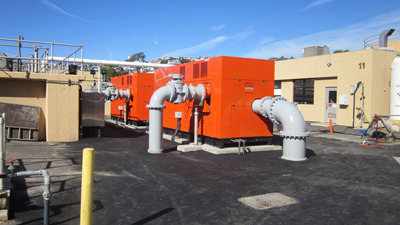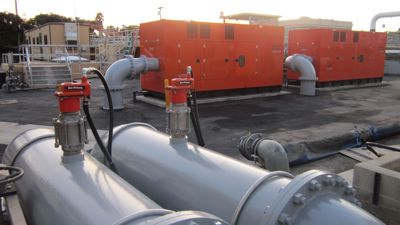To prevent sanitary sewer overflows, pumping must be reliable and continuous, even through power loss and mechanical problems.
After the Great Depression, the government supplied money intended for infrastructure investment and rebuilding. Methods were sought to improve the quality of old systems and allow for the installation of improved and forward-thinking new systems. People no longer sought the fastest, easiest or cheapest decision, but the best decision.
When funding became available, companies began the work to improve and strengthen their processes and replace the low-priced, simple fixes that they had been relying on before and during the Depression.
 |
| Critically silenced pumpsets installed at the J.B. Latham Treatment Plant |
In the wake of the global economy's most recent recession and subsequent upturn, the U.S. has once again turned to rebuilding infrastructures and finding the best solutions for long-term needs. The smartest companies have moved toward providing solutions that sustain their broken and temporary existing infrastructures in an effort to make better, permanent decisions that promote environmental sustainability and population growth.
It is with this in mind that municipalities have begun to take a closer look at backup pumping plans from every conceivable angle, in search of a better, more dependable, more complete solution.
Less Power, More Pump
Since the inception of backup power availability, using a diesel-driven generator for alternative power in the event of an outage has always seemed the most straightforward, cost-effective approach for superior lift station reliability. However, risks and shortcomings are associated with this method of contingency planning, such as:
If failure occurs with the generator, transfer switch, control panel or electric submersible pumps, standby generators that create electrical power are useless.
Initial and ongoing costs can actually be higher with generators.
They are usually load-tested to ensure reliable power during emergencies, and sometimes these tests require specialized personnel.
Because of these shortcomings—and given the increasing cost of fines associated with system overflows—backup pumping solutions have been earning a larger share of the municipal spotlight.
Backup pumping increases the flexibility to perform repairs or preventive maintenance on permanently installed pumps. They also reduce the repair or replacement costs
associated with unforeseen failures.
This broader form of standby reliability is free from the dangers associated with being tied to other power sources. As an increasingly more suitable and reliable pumping station backup, the installation of independently powered, diesel-driven automatic self-priming standby pumping units with level sensors, controllers and piping has also drawn interest in the treatment facility segment of wastewater operations.
Case Study
In Dana Point, Calif., the Operations Department of the J.B. Latham Treatment Plant had concerns regarding potential spills that might occur as a result of power loss and mechanical problems at its influent pump station. The treatment plant plays into the water system surrounding Southern California, and is less than 1,000 yards from the Pacific Ocean.
The design engineer firm working on the plant reached out to a pump manufacturer to engineer a diesel-driven, automatic backup pumping system with the capacity to generate an average flow of 7,820 gallons per minute, and a maximum flow of 22.5 million gallons per day.
The design was based on two of the pump manufacturer's critically silenced diesel-driven pumpsets. Each system can handle 8,400 gallons per minute out of the box. However, the Latham Plant required that the pumpsets be modified to include an extended suction line. Dual compressors were installed on the pumpsets, one of which ran an external priming assembly near the suction source at the wet well.
 |
| Dual compressors installed on the pumpsets, one of which ran an external priming assembly |
Due to pump design space restrictions, a standard configuration was not an option. The pump volute was rotated 180 degrees to suit the space limitations, with the discharge occurring on the opposite side of the pump.
A controller panel was used, which allowed for automatic start and stop of the pumping system with no operator intervention. Based on its interactions with the pump system's electronic diesel engine, the controller allowed for inputs from level, flow, pressure transducers or standard floats. So, when the power fails—intentionally or unintentionally—the level in the wet well will rise, and the pump will prime and start automatically, continuing to regulate wastewater throughput with controlled efficiency until the main wet-well pumps can be put back online.
There are many benefits to having a complete backup pump station in a treatment facility:
- The ability to schedule and perform maintenance
- Continuous pumping during wet-well pump repair
- Supplemental pumping during storm water infiltration or power outages
For a price comparable to backup generator installation, backup pumping systems provide the reliability of a self-starting unit that is independent of electric power and reduces the risks associated with mechanical failure in both the traditional lift station and its typical generator-based contingency plan.
These self-contained, backup pumping units, available in soundproof enclosures, meet common municipal codes for noise. With no additional electrical work or customization required, this alternative provides greater potential for accelerated construction, resulting in a permanent solution to an emergency or planned shut-down, without the need to replace with an improved product when time or funding allows. The pumping solution is comparable in initial cost and more cost-effective in terms of life cycle costs.
How Does It Work?
A backup pumping system runs independent of utility line power and lift station pump control and can meet system demands during emergency power outages, planned rolling blackouts and preventative maintenance measures. Start and stop controls are provided by either a pressure transducer or float switches located in the wet well that activate the diesel- or natural gas-driven pumps when wet-well sewage levels rise to a preset height.
The automatic priming feature removes air from the suction line and creates a vacuum, which allows the sewage to rise and primes the pump. The pumpset continues to operate and pump the required flow. It shuts off when either the wet well is lowered or the electricity is restored and the primary system regains control.
The final result is that the emergency backup pumping system and the regular pumping system run independent of each other and do not rely on each other.
As a result, these units represent true redundancy. If the level sensor indicates a need, the standby pumping unit starts without the need for a transfer switch or other common control elements. This reduces the inherent flaws and risks originally associated with backup pumping operations linked to backup power. One-unit solutions are more reliable than their counterparts and result in a more streamlined solution that is able to prevent more sanitary sewer overflows (SSOs) and negative impacts to the environment.
The packaged backup pumping solution is cleaner, sound-attenuated and ideal for residential areas. Its greater reliability ultimately translates to less impact on daily life for the community surrounding the installation, offering smarter, more sustainable technology.
Pumps & Systems, March 2011
Kristen Gurick is a marketing communications specialist for Godwin Pumps.

